Signs of Termites: How to Spot a Potential Infestation
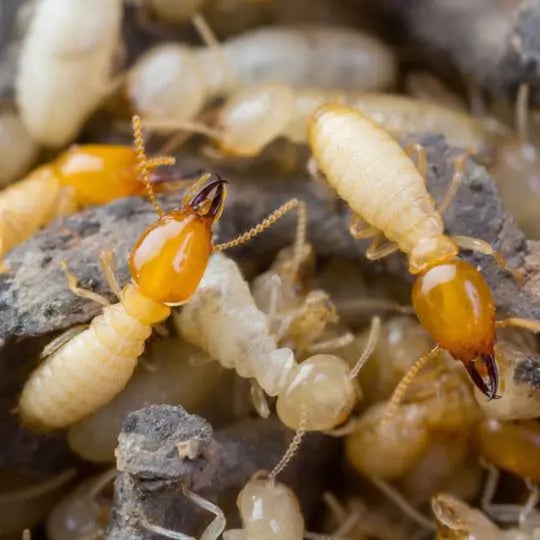
Unseen and elusive, a termite infestation is like a silent predator that feasts on your precious home without giving a hint of its presence. By the time you notice the damage, it’s already too late.
What is a Termite Infestation
Unwanted guests of the six-legged variety, termites have a knack for invading buildings and their surroundings. When these critters are found scurrying around in, on, or beneath a structure or its foundation, it constitutes a termite infestation.
With a keen eye and some expert knowledge, you can unlock the secrets of identifying these sneaky pests before they wreak havoc.
So, gear up, grab a magnifying glass, and join the quest to uncover the subtle signs of a termite invasion. The hunt starts now!
Table of Contents
-
Early Warning Signs of Termites
-
Visible Destruction From Termites
Don’t ignore these early signs of a termite presence and be on the lookout for these telltale clues:
Early Warning Signs of Termites
Wings
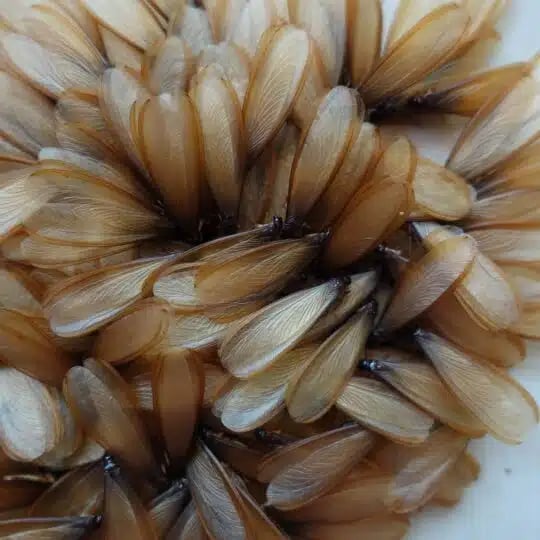
The sight of wing fragments, resembling piles of fish scales, scattered inside or outside your home could signify a termite infestation.
The swarmers or reproductives, after finding the perfect spot, discard their wings which could be seen on spider webs as well.
As the warmer months approach, between February and June, be vigilant for large quantities of wings around sources of heat like chimneys, furnaces, and stoves.
Mud Tubes
One of the most notable is their unmistakable signs of termites is mud tubes. Imagine seeing long, thin mounds of mud around your building.
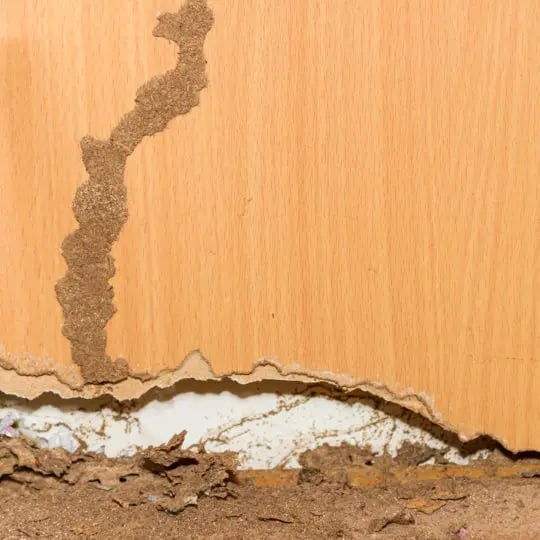 That’s exactly what these tunnels look like, and they’re usually found along wood beams, foundations, and exterior walls. The makeshift structures are made of a combination of dirt and bugs’ fecal matter, which sounds gross, but serves as a way for the creatures to travel between their nest and feeding spots, free from harm.
That’s exactly what these tunnels look like, and they’re usually found along wood beams, foundations, and exterior walls. The makeshift structures are made of a combination of dirt and bugs’ fecal matter, which sounds gross, but serves as a way for the creatures to travel between their nest and feeding spots, free from harm.
Subterranean termites are particularly skillful in seeking new food sources, and their shelter tubes often climb onto outdoor surfaces like they have a mind of their own. It’s only when damage has been done that their presence is typically detected. So if you see these mud pipes, it’s time to act fast.
Frass/Poop
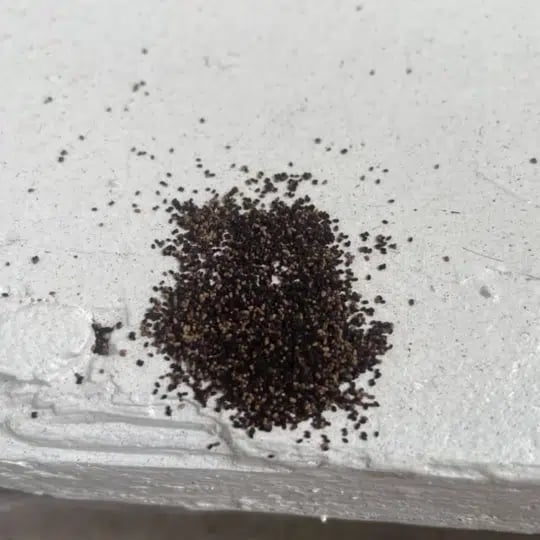 Termites might be tiny, but they can leave a big (and smelly) mark on your home. Meet frass, the official name for termite waste.
Termites might be tiny, but they can leave a big (and smelly) mark on your home. Meet frass, the official name for termite waste.
These pesky bugs love to munch on wood, and as a result, they leave behind piles of sandy pellets that resemble pepper. Keep an eye out for these small but mighty droppings if you suspect a termite infestation.
Don’t let frass put a damper on your home sweet home.
Actual Termites
You can still have an issue even if you don’t see any living termites, but it helps to know what to look for in case you do see them.
These hungry pests range in size from 1/8” to 1” long, and can vary in color depending on their species and age.
Termites come in shades of brown, black, and even white.
Although they are sometimes mistaken for flying ants, termites have straight antennae, while flying ants have bent ones.
Swarms
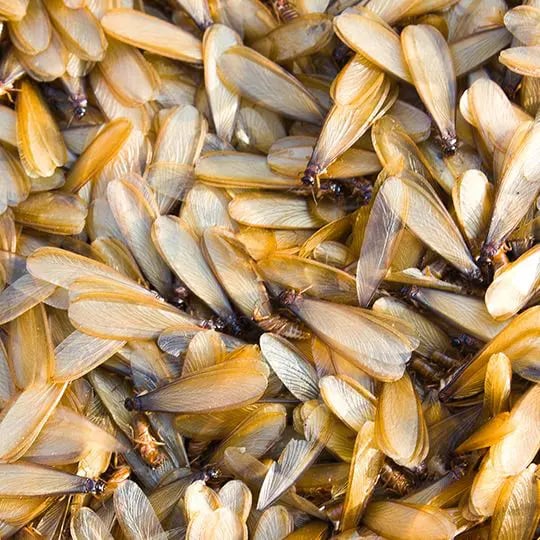
When a termite colony reaches its full potential, they don’t just sit tight and bask in its success. Instead, they send out a fleet of winged termites (which may easily be mistaken for flying ants) to venture off into the unknown and establish a new home – a process known as swarming. This typically occurs during the springtime and is a clear indicator of termite activity, particularly if you spot a bunch of wings scattered around your windowsills or baseboards.
These swarms also consist of termite kings and queens, who have the pivotal role of creating a brand new colony from scratch.
So, if you ever come across a termite swarm, know that it’s a sign of a mature colony that has been growing and thriving for a good 3-5 years.
Visible Destruction From Termites:
Damage to wood siding, window frames, steps, flooring, joists, beams, and framework in walls is also an indication of a termite infestation.
Floor damage
Your beautiful flooring can suddenly take on a less-than-pristine look, with tiles going loose, floorboards warping and squeaking, or laminated floors buckling. These frustrating signs of damage are often attributed to wear and tear, but termites are often the unseen culprit. The tiny, insidious insects introduce additional moisture that can wreak havoc on your beautiful floors. The result? Loose tiles, warped wooden floorboards, and buckled laminated floors — a daunting reminder of the destructive power of these little pests.
Wall damage
Termites may seem like tiny little pests, but their damage is anything but small. If you suspect your home is infested, take a close look at your walls – they could hold the evidence you need. Keep an eye out for discolored patches or drooping drywall, as well as small holes that seem to appear out of nowhere. And don’t be fooled by peeling paint – it could be a sign of excessive moisture caused by termite activity. Your walls are like a canvas, but when it comes to termites, they can paint an ugly picture. Keep them in tip-top shape, and if you notice any of these symptoms, call in the professionals.
Wood damage
Your home may be under attack by tiny creatures if you notice your wooden fixtures sounding hollow when knocked on or looking damaged without explanation. Unfortunately, termites absolutely love devouring wood, making it one of their go-to sources of sustenance. Keep your ears perked for a hollow sound and your eyes peeled for any unexplained damage, as it could be a sign of trouble.
Get a Pro Involved
Termites are no laughing matter. They act fast and their destruction is expensive to repair. If you suspect termite activity in your home, the time to act is now. Contact the knowledgeable exterminators at Green Pest Solutions to prevent these pests from further damaging your home.
Call us today at 855-312-7157 to schedule a free estimate.